I was really too early for the big show, so these are just the earliest of the spring bloomers. The really low alpines were from the top of the mountains while the bulbs were from lower down.
Anemone fanniniae
Asclepias stellifera
Erica cerinthoides
Eriosema kraussianum
Haplocarpha nervosa
Comments
Re: Late October in the Drakensbergs, Lesotho
last set. Later I'll post from some other areas of South Africa...the Proteaceae deserve their own thread!
Hypoxis rigidula
pentasinia prunelloides
Scadoxus puniceus
Sutherlandia frutescens
Watsonia lepida
Re: Late October in the Drakensbergs, Lesotho
Lower down, the Drakensberg were greening up quite nicely but at the top of Sani Pass, it was still quite brown.
Re: Late October in the Drakensbergs, Lesotho
Very interesting, Todd! Both plants and landscape is different from where I have been (Western Cape (Fynbos) and Great Karoo).
Did you find the birds you were looking for?
Now I am looking forward to your Proteaceae thread.
Re: Late October in the Drakensbergs, Lesotho
Todd, that was a real treat to see your photos from Lesotho. I was at Kirstenbosch for a couple of weeks as a volunteer back in the 90s sometime, I think, and was taken for a hike in the Fynbos - wonderful. Would like to go again but fear they wouldn't want an "older" person like me as a volunteer now. I too look forward to your Protea thread. Brought back some Disa orchids in agar but no luck. However, a Haemanthus deformus (what a name, eh?) has survived well and has babies flowering as well. Will try to get a photograph of it to post. Fran
Frances Howey, London, Ontario, Canada, Zone 5b
Re: Late October in the Drakensbergs, Lesotho
Here is my pic of Haemanthus deformis. Fran
Frances Howey, London, Ontario, Canada Zone 5b
Re: Late October in the Drakensbergs, Lesotho
Super display, Todd.
Re: Late October in the Drakensbergs, Lesotho
Great photos, Todd! The Helichrysum confertum is something really special.
Re: Late October in the Drakensbergs, Lesotho
Nice Haemanthus Fran.....it took lots of patience to grow that from seed. I didn't get any seeds while there although they were selling some at Kirstenbosch.
Re: Late October in the Drakensbergs, Lesotho
Great series Todd, some most unusual and distinctive plants, and majestic scenery. Of course we expect showy Helichrysum from S. Africa, and we see some nice ones here to be sure. But I am struck by two plants in particular, the first is Asclepias stellifera. Not only is it attractive, but now I'm wondering about how far flung are milkweed species in this interesting genus. Looks like a smallish affair and worthy of cultivation.
The second is Hypoxis rigidula. For North Americans only familiar with H. hirsuta (common goldstar) found throughout most of eastern USA and parts of Canada, it might come as a surprise that there are many species (approximately 100); South Africa being the epicenter of speciation. I used to grow 4-5 South African species. They were tender and I had to overwinter them indoors. In growth they were leafy and shy with blooms. Eventually I decided they were not ornamental enough to be worth the bother of overwintering indoors (I have little space for this) and gave them up. Hypoxis rigidula was among those that I grew.
As to "Pentasinia", I believe a couple letters are reversed and the genus name is actually Pentanisia. It is a member of Rubiaceae. I had to look up this plant as it is completely new to me, but certainly seems attractive. It grows 2' tall and is a grassland plant found at lower elevations but also grows up to nearly 2000 meters. The plants seems slightly reminiscent of Amsonia. From what I see of Pentanisia prunelloides, I like it! The plant is reported as having lots of local medicinal uses:
http://www.plantzafrica.com/plantnop/pentanprunel.htm
Re: Late October in the Drakensbergs, Lesotho
Thnaks Mark for finding the typo...my typing fingers are often dyslexic! That Asclepias was indeed quite small as far as milkweeds go...about 25 cm. with tidy, almost grass-like leaves.


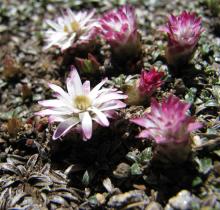
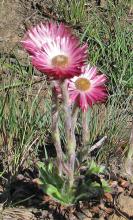
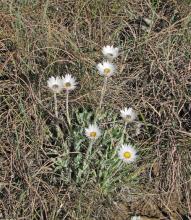
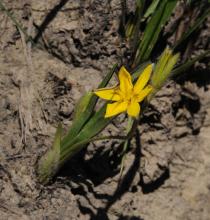


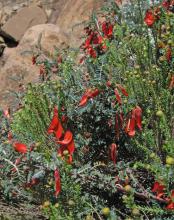
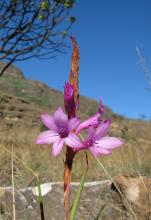
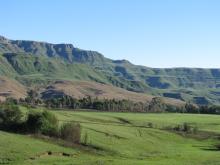
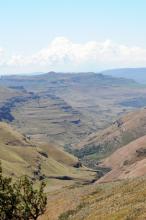
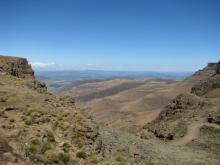
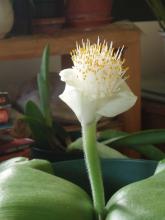
Some Helichrysums
Helichrysum aureum
Helichrysum confertum
Helichrysum ecklonis
Helichrysum sp.